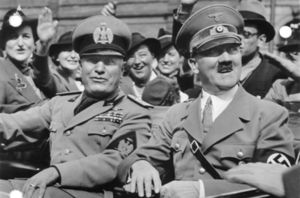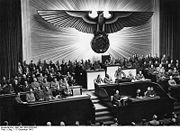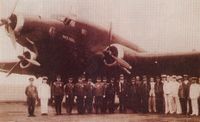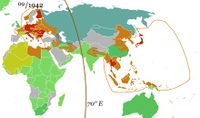قوات دول المحور
The Axis powers | |
|---|---|
| 1940–1945 | |
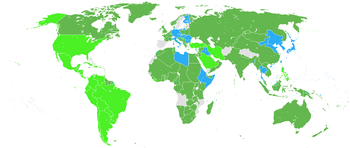
States that adhered to the Tripartite Pact:
Co-belligerent states:
| |
| الوضع | Military alliance |
| الحقبة التاريخية | World War II |
| 25 November 1936 | |
| 22 May 1939 | |
| 27 September 1940 | |
| 2 September 1945 | |
| |
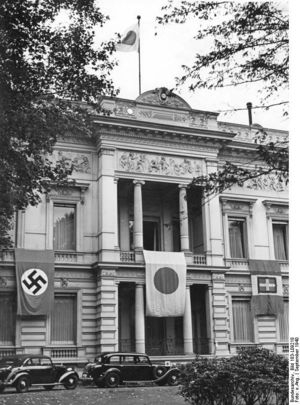
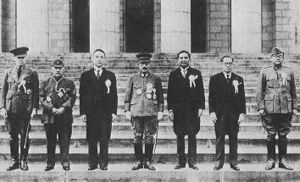
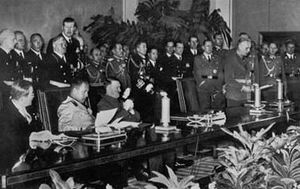
قوات دول المحور في الحرب العالمية الثانية تضم أساسا ألمانيا النازية بقيادة أدولف هتلر وإيطاليا بقيادة بينيتو موسوليني ثم انضمت إليهم اليابان بقصفها لميناء بيرل هاربور الأمريكي وانضم إليهم دول أخرى مثل النمسا ورومانيا وبلغاريا والمجر.
بدأت الحرب العالمية الثانية عام 1938 واستمرت حتى عام 1945 وكانت الحرب أساسا بين دول المحور الثلاثة (الإمبراطورية اليابانية - الفاشية الإيطالية - النازية الألمانية) ضد دول التحالف (الاتحاد السوفيتي - بريطانيا - الولايات المتحدة الأمريكية) التي انتهت بانتصار دول الحلفاء.
التعاون الألماني الإيطالي الياباني في الحرب العالمية الثانية
تعاون المحور الألماني-الياباني
إعلان كلٍ من ألمانيا وإيطاليا الحرب على الولايات المتحدة
On 7 December 1941, Japan attacked the US naval bases in Pearl Harbor, Hawaii. According to the stipulation of the Tripartite Pact, Nazi Germany and Fascist Italy were required to come to the defense of their allies only if they were attacked. Since Japan had made the first move, Germany and Italy were not obliged to aid her until the United States counterattacked. Nevertheless, expecting the US to declare war on Germany in any event,[1] Hitler ordered the Reichstag to formally declare war on the United States.[2] Hitler had agreed that Germany would almost certainly declare war when the Japanese first informed him of their intention to go to war with the United States on 17 November 1941.[3] Italy also declared war on the U.S..
Historian Ian Kershaw suggests that this declaration of war against the United States was a serious blunder made by Germany and Italy, as it allowed the United States to join the war in Europe and North Africa without any limitation.[4] On the other hand, American destroyers escorting convoys had been effectively intervening in the Battle of the Atlantic with German and Italian ships and submarines, and the immediate war declaration made the Second Happy Time possible for U-boats.[5] The US had effectively abandoned its neutral stance in September 1940 with the Destroyers for Bases Agreement, before dropping all pretence of neutrality in March 1941 with the beginning of Lend-Lease. Admiral Erich Raeder had urged Hitler to declare war throughout 1941 so the Kriegsmarine could begin sinking American warships escorting British convoys.[6] Following the "Greer incident" on 4 September 1941, when the German U-boat U-652 fired on the American destroyer Greer, Roosevelt confirmed that all US ships escorting convoys had been ordered to "shoot on sight" at all Axis ships and submarines in the Atlantic.[7] This order effectively declared naval war on Germany and Italy.[8] In the "Kearny incident" on 17 October 1941 the USS Kearny dropped depth charges on German U-Boats, before being torpedoed by the U-568 - 11 American servicemen were killed and 22 injured. The US destroyer Reuben James was torpedoed and sunk by the submarine U-552 on 31 October 1941. Franklin D. Roosevelt had said in his Fireside Chat on 9 December 1941 that Germany and Italy considered themselves to be in a state of war with the United States.[9] Plans for Rainbow Five had been published by the press early in December 1941,[10] and Hitler could no longer ignore the amount of economic and military aid the US was giving Britain and the USSR.[11] The Plan Dog memo had determined in 1940 that the US would pursue a Europe first strategy by focusing on defeating Germany and Italy while fighting a defensive war in the Pacific.[12] Americans played key roles in financing and supplying the Allies, in the strategic bombardment of Germany, and in the final invasion of the European continent.
Hitler declaring war on the United States on 11 December 1941
Italian pilots of a Savoia-Marchetti SM.75 long-range cargo aircraft meeting with Japanese officials upon arriving in East Asia in 1942.
انظر أيضاً
- Axis leaders of World War II
- Axis power negotiations on the division of Asia during World War II
- Central Powers
- Expansion operations and planning of the Axis powers
- Foreign relations of the Axis powers
- Greater East Asia Co-Prosperity Sphere
- Greater Germanic Reich
- Hakkō ichiu
- Hypothetical Axis victory in World War II
- Imperial Italy (fascist)
- List of pro-Axis leaders and governments or direct control in occupied territories
- New Order (Nazism)
- المشاركون في الحرب العالمية الثانية
- Zweites Buch
ملاحظات
المراجع
- ^ Kershaw, Ian. Fateful Choices: Ten Decisions the Changed the World, 1940-1941 New York: Penguin, 2007. pp.444-46 ISBN 978-1-59420-123-3
- ^ Kershaw 2007, p. 385.
- ^ Longerich, Peter Hitler: A Life (2019) p. 784
- ^ Kershaw 2007, Chapter 10.
- ^ Duncan Redford; Philip D. Grove (2014). The Royal Navy: A History Since 1900. I.B. Tauris. p. 182. ISBN 9780857735072.
- ^ Murray, Williamson & Millet, Alan A War to Be Won Fighting the Second World War, Cambridge: Belknap Press, 2000, ISBN 9780674006805., p. 248
- ^ ""Shoot on sight" speech regarding attack on USS GREER".
- ^ Burns, James MacGregor (1970). Roosevelt: The Soldier of Freedom. Harcourt Brace Jovanovich. hdl:2027/heb.00626. ISBN 978-0-15-678870-0. p. 141-42
- ^ "Franklin D. Roosevelt: Fireside Chat". www.presidency.ucsb.edu.
- ^ "Historian: FDR probably engineered famous WWII plans leak". upi.com.
- ^ "BBC On This Day - 11 - 1941: Germany and Italy declare war on US". BBC News. BBC. 11 December 1941.
- ^ "Plan Dog | Operations & Codenames of WWII". Archived from the original on 2019-02-17. Retrieved 2019-02-16.
وصلات خارجية
- Articles with hatnote templates targeting a nonexistent page
- Missing redirects
- Short description is different from Wikidata
- Articles containing ألمانية-language text
- Articles containing إيطالية-language text
- قوى المحور
- تأسيسات 1940
- انحلالات 1945
- دول وأقاليم تأسست في 1940
- دول وأقاليم انحلت في 1945
- تحالفات عسكرية في القرن العشرين
- فاشية
- مناهضة الشيوعية
- امبراطوريات سابقة
- العلاقات الألمانية الإيطالية
- العلاقات الألمانية اليابانية
- العلاقات الإيطالية اليابانية
- سياسة الحرب العالمية الثانية
- الحرب العالمية الثانية
